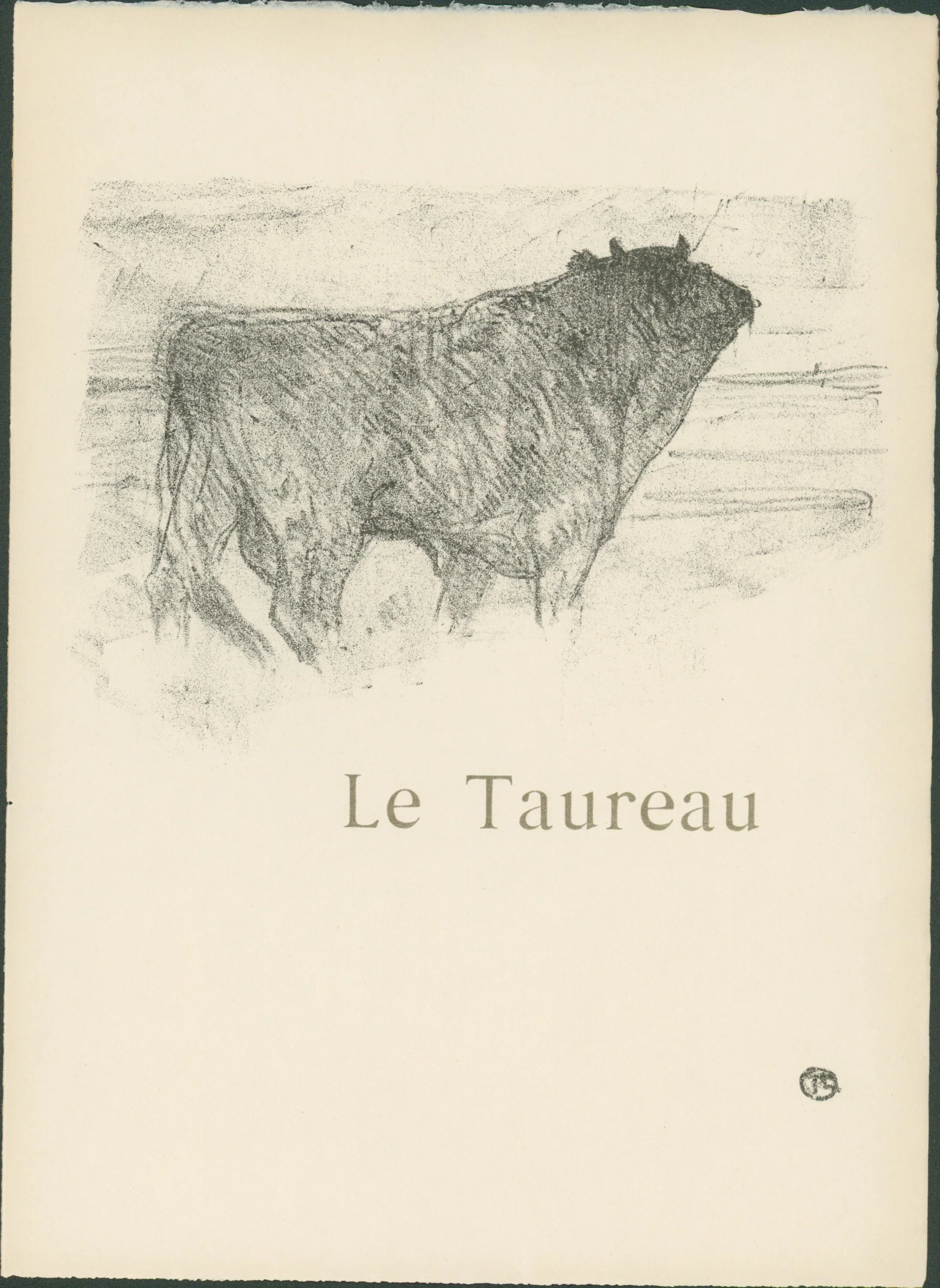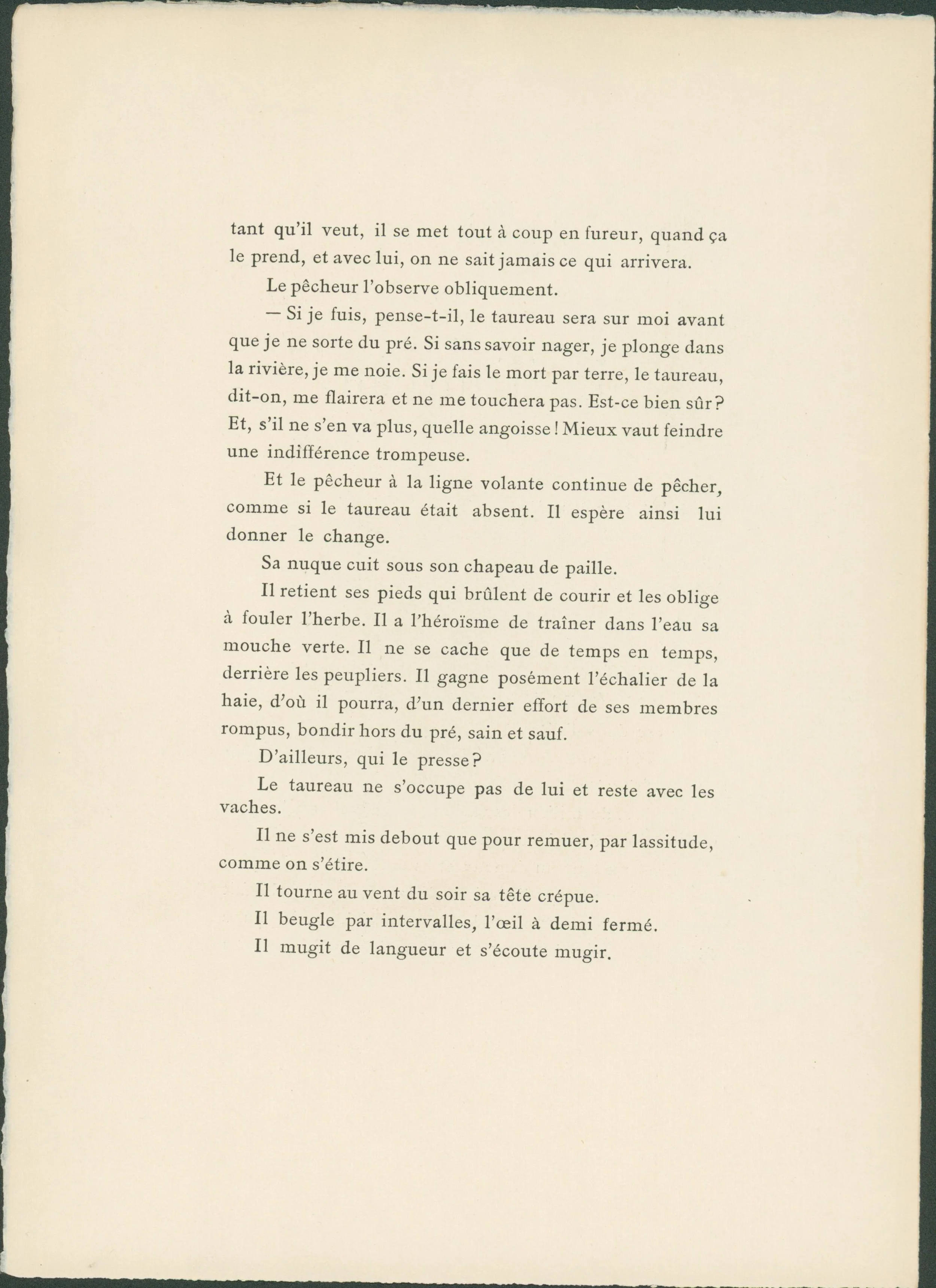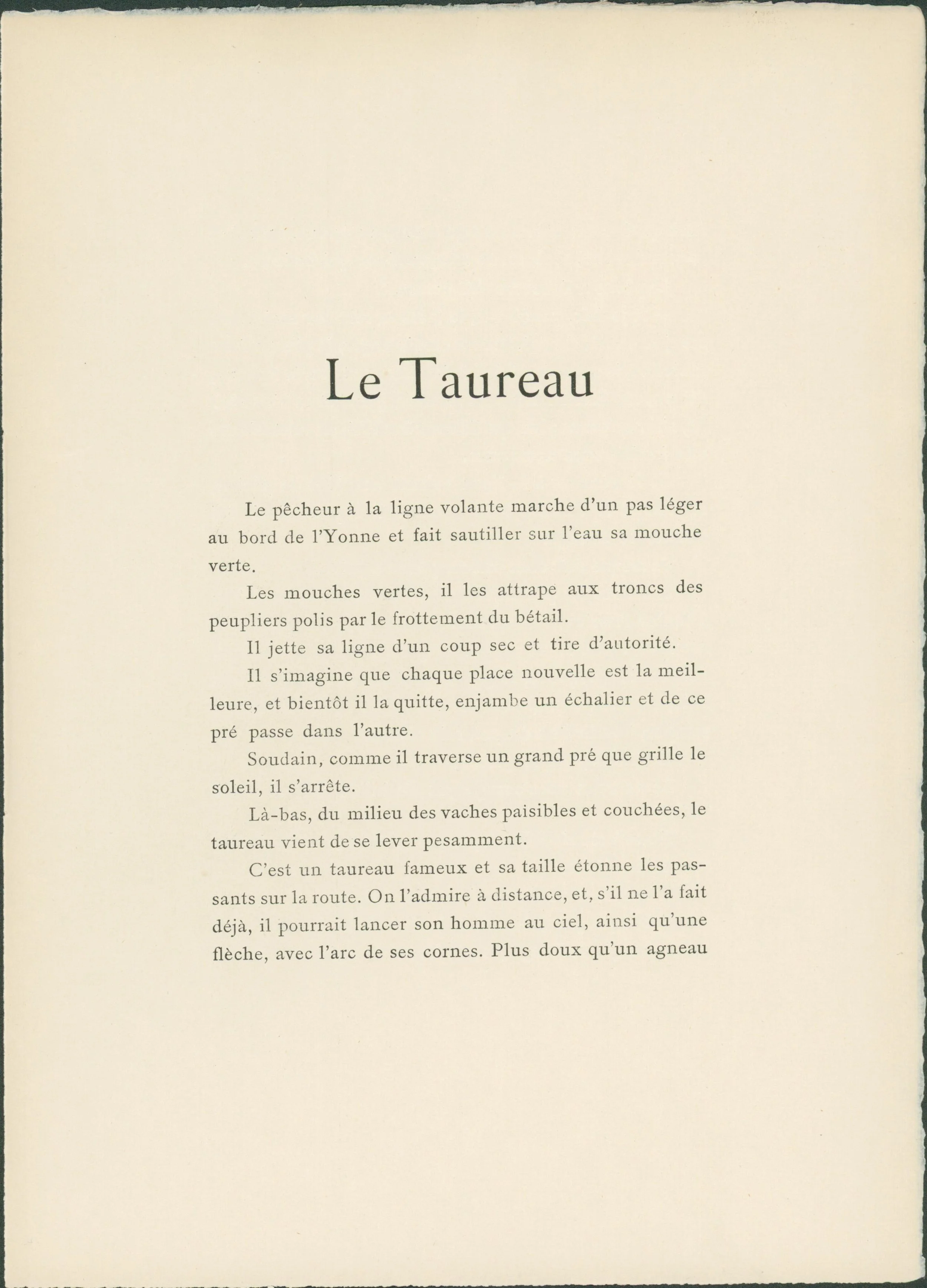




Henri de Toulouse-Lautrec — Histoires naturelles - The Bull (1899)
This exquisite original lithograph of Bull by Henri de Toulouse-Lautrec (1864–1901) comes complete with the two pages Jules Renard description.
originates from Histoires naturelles, a rare collaborative publication with the French writer Jules Renard (1864–1910). Issued in Paris by H. Floury in 1899, the edition was strictly limited to 100 examples, of which this is number 49. Each print was executed on fine paper and often accompanied by Renard’s corresponding text sheet when available.
The series represents some of Toulouse-Lautrec’s most delicate and precise draughtsmanship. While Renard’s text captures the wit and subtle observation of his bestiary, Lautrec translated these character sketches into graceful, sometimes mischievous visual form. Although the two men reportedly clashed over the tone and choice of animals, the resulting portfolio is now recognised as one of the great achievements of fin-de-siècle illustrated books. (Not included are the front cover and the edition page, seen attached for context)
Lautrec completed this work late in his life, around the same time he was recovering from illness and confinement. His remarkable ability to conjure vitality and humour from memory alone convinced his doctors that his mind had cleared—an episode he famously summarised as “I bought my freedom with my drawings.”
Renard, a member of the Académie Goncourt, remains celebrated for his sharp and humane prose in works such as Poil de Carotte and Le Plaisir de rompre. Histoires naturelles brings together two very different but equally modern sensibilities at the height of the Paris literary-artistic scene.
Medium: Original lithograph (from the 1899 H. Floury edition, limited to 100)
Paper size: approximately 22.9 × 31.8 cm
Date: 1899
Condition: Very good to excellent overall; light age toning and minor foxing may be present consistent with age. Please refer to the images for an accurate visual impression.
References: Comparable examples discussed in Garvey, Graphic Art of Toulouse-Lautrec (304); Donson/Gripp, Toulouse-Lautrec, Master of the Poster.
Rarity and Significance
Printed by H. Floury in Paris in a limited edition of 100 copies, Histoires naturelles is now recognised as one of the rarest illustrated books of the nineteenth century. Each lithograph was individually drawn on the stone by Lautrec, the impressions noted for their subtle tonal variation and velvety texture. Complete examples seldom appear at auction, and individual plates, when accompanied by the original text leaf (as here), are particularly desirable to collectors of both modern French literature and Belle Époque graphic art.
Many “Toulouse-Lautrec” lithographs seen online are 20th-century restrikes or reproductions printed decades after the artist’s death (often around 1950–1980) and marked “in plate – TL” or “after Lautrec.”
This work is from the original 1899 H. Floury edition of 100, drawn on stone and bearing Lautrec’s authentic studio TL monogram stamp.
It is fully documented in the Wittrock Catalogue Raisonné and represents a genuine 19th-century impression—not a later reproduction.
This exquisite original lithograph of Bull by Henri de Toulouse-Lautrec (1864–1901) comes complete with the two pages Jules Renard description.
originates from Histoires naturelles, a rare collaborative publication with the French writer Jules Renard (1864–1910). Issued in Paris by H. Floury in 1899, the edition was strictly limited to 100 examples, of which this is number 49. Each print was executed on fine paper and often accompanied by Renard’s corresponding text sheet when available.
The series represents some of Toulouse-Lautrec’s most delicate and precise draughtsmanship. While Renard’s text captures the wit and subtle observation of his bestiary, Lautrec translated these character sketches into graceful, sometimes mischievous visual form. Although the two men reportedly clashed over the tone and choice of animals, the resulting portfolio is now recognised as one of the great achievements of fin-de-siècle illustrated books. (Not included are the front cover and the edition page, seen attached for context)
Lautrec completed this work late in his life, around the same time he was recovering from illness and confinement. His remarkable ability to conjure vitality and humour from memory alone convinced his doctors that his mind had cleared—an episode he famously summarised as “I bought my freedom with my drawings.”
Renard, a member of the Académie Goncourt, remains celebrated for his sharp and humane prose in works such as Poil de Carotte and Le Plaisir de rompre. Histoires naturelles brings together two very different but equally modern sensibilities at the height of the Paris literary-artistic scene.
Medium: Original lithograph (from the 1899 H. Floury edition, limited to 100)
Paper size: approximately 22.9 × 31.8 cm
Date: 1899
Condition: Very good to excellent overall; light age toning and minor foxing may be present consistent with age. Please refer to the images for an accurate visual impression.
References: Comparable examples discussed in Garvey, Graphic Art of Toulouse-Lautrec (304); Donson/Gripp, Toulouse-Lautrec, Master of the Poster.
Rarity and Significance
Printed by H. Floury in Paris in a limited edition of 100 copies, Histoires naturelles is now recognised as one of the rarest illustrated books of the nineteenth century. Each lithograph was individually drawn on the stone by Lautrec, the impressions noted for their subtle tonal variation and velvety texture. Complete examples seldom appear at auction, and individual plates, when accompanied by the original text leaf (as here), are particularly desirable to collectors of both modern French literature and Belle Époque graphic art.
Many “Toulouse-Lautrec” lithographs seen online are 20th-century restrikes or reproductions printed decades after the artist’s death (often around 1950–1980) and marked “in plate – TL” or “after Lautrec.”
This work is from the original 1899 H. Floury edition of 100, drawn on stone and bearing Lautrec’s authentic studio TL monogram stamp.
It is fully documented in the Wittrock Catalogue Raisonné and represents a genuine 19th-century impression—not a later reproduction.
